Dairy Farmers Wanted In Digester Conversation
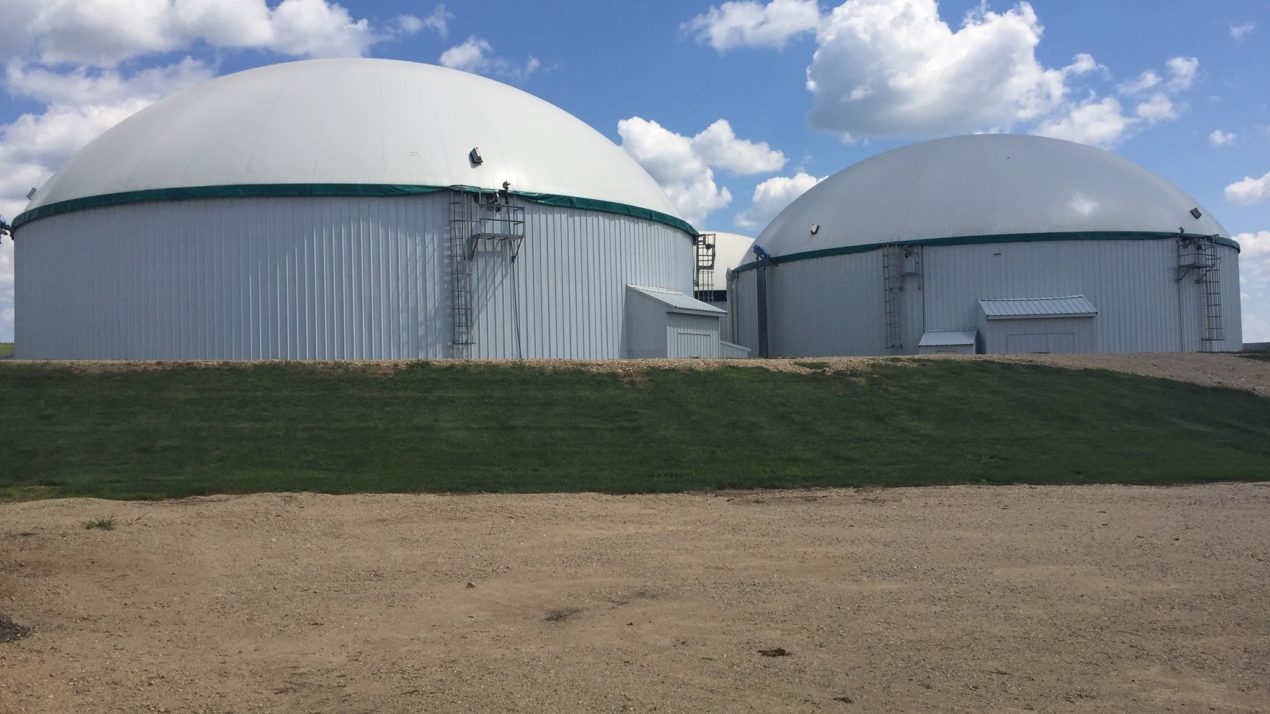
Dairy cattle manure is already recognized as a valuable fertilizer, but its potential as a renewable energy source has still not been fully realized.
Dairy farmers often do not consider biomass energy investments because of the regulatory and business hurdles they can face, explains John Holevoet, director of government affairs at the Dairy Business Association.
DBA has partnered with the Wisconsin Biomass Energy Coalition in efforts to make digesters and biomass energy investments more appealing in Wisconsin. WBEC is a nonprofit, independent trade association launched in 2019 with a mission to advance policy solutions supporting nutrient management and water quality challenges through renewable natural gas digester facilities.
DBA has joined WBEC to ensure the dairy community has a seat at the table planning the future of renewable energy opportunities in Wisconsin. WBEC believes that dairy farmers have an important story to share and is waiving the $500 annual membership for DBA producer members.
To learn more or join WBEC, contact Anne Hauer at [email protected]
In his interview with the Mid-West Farm Report, Holevoet also highlights some of the initiatives the DBA wants passed in the legislative session this fall, including the ‘truth-in-labeling’ bills, which in order to be effective, relies on other states to implement.
Evers Proclaims Farm Safety Week

Wisconsin’s farmers and agriculturists are essential to Wisconsin and its economy, contributing $104.8 billion dollars to it’s economy annually.
The safety and health of farmers is of top priority, says Gov. Tony Evers, focusing on preventing injury and death on Wisconsin farms. Evers has officially proclaimed Sept. 19-25, 2021 as Wisconsin Farm Safety and Health Week.
He writes: “farms can be made safer through agricultural leadership and workplace safety education for farmers, agricultural workers and family members.”
See the full proclamation below:
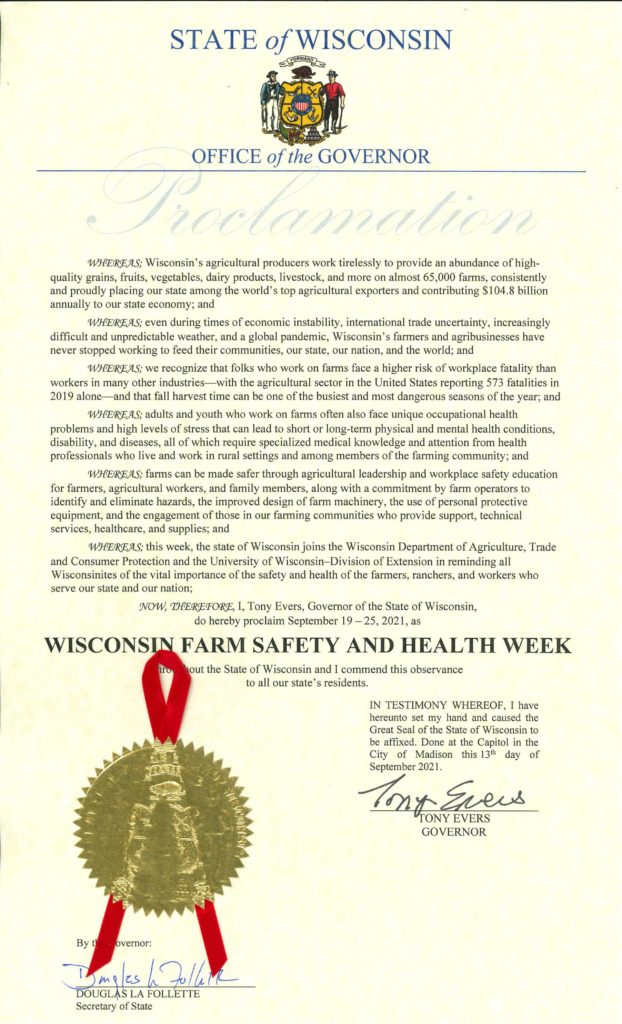
Look Out For Each Other

September is Suicide Prevention Awareness Month. Suicide Prevention Coalition of Iowa County founder and outreach coordinator Susan Springer references 820 suicides in 2020 as reported by the Department of Health Services.
For every one of those 820 suicides, there were 25 attempts, she says. And farmers are not immune to mental health crises that result in depression and suicide.
Springer says this time of year — harvest and fieldwork — leaves farmers with little sleep and a lot of stress. Farmers also deal with a lot of chemicals that can have side effects, including depression, that can lead to suicide. Physical injuries can also lead to mental illness — head injuries and trauma from getting in and out of machinery and not getting looked at by a doctor can lead to depression symptoms.
She adds mold exposure and Lyme’s disease to the list of physical exposure that can cause depression that leads to suicide.
If you are struggling, ask for help. If you a friend seeing someone struggle, don’t be afraid to say something, Springer emphasizes.
In addition, isolation during the pandemic has led to a rise in suicides, she says. But call volumes are down. Springer works with the Journey Mental Health Crisis Mobile Unit. An increase in suicides but not call volumes are indicating that people are not reaching out for help before attempting suicide.
Mental health crisis or suicide response trainings (QPR trainings) are taking place near you this month and in the future. If you’re interested, contact Suicide Prevention Coalition of Iowa County. They will connect you to upcoming events in your area. Find them on Facebook. Email: [email protected] Website: https://www.suicide-iowacountywi.org/
Camp HOPE is a free weekend camp for grieving children, teenagers & their families Oct. 9-10 at the Wisconsin Lions Camp in Rosholt. Registration deadline is Saturday, Sept. 18. Visit camphopeforkids.org or call (715) 341-0076.
National Eateries Hanker For Wisconsin Dairy
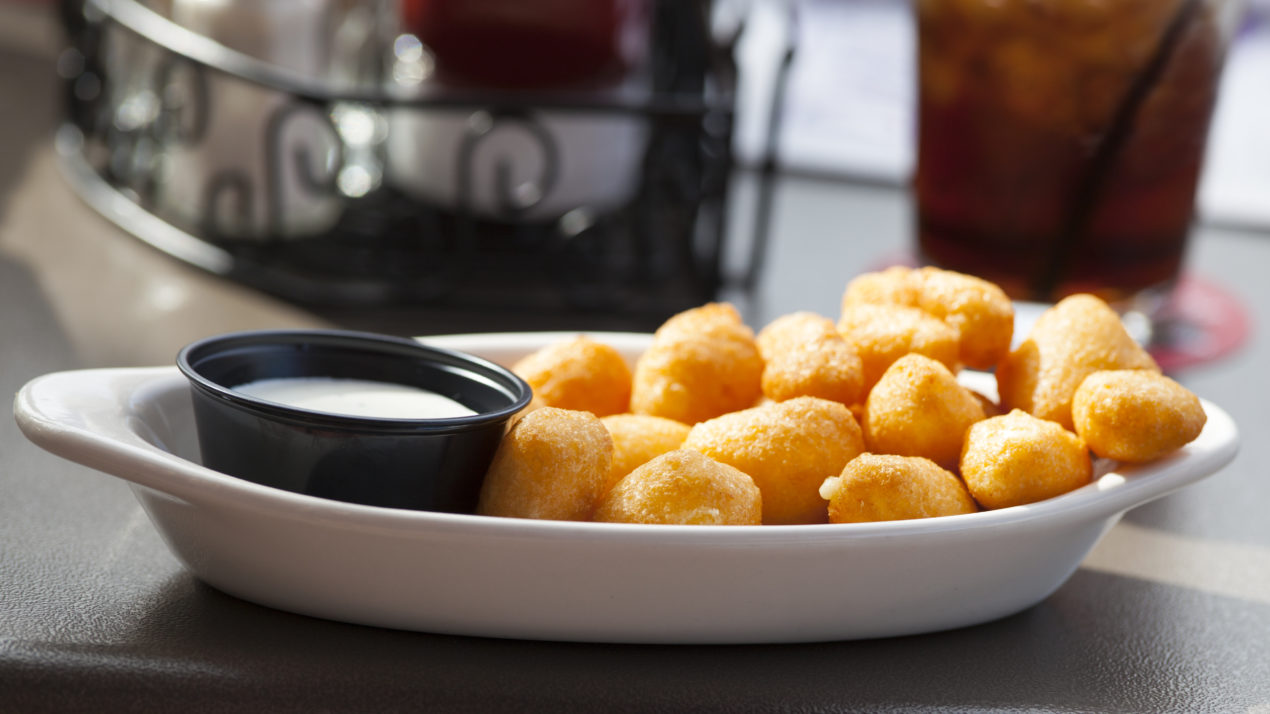
In 2019, international fast food chain A&W sold over 7 million pounds of Wisconsin cheese curds. Lined up end-to-end, the curds would equal two round trips from Milwaukee to Green Bay, according to Dairy Farmers of Wisconsin.
Building relationships between Wisconsin dairy and restaurants nationwide is the job of Rick Findlay, the vice president of food service at DFW, the marketing arm for the state’s dairy industry. Findlay says DFW has been working with A&W for about five years.
He says what drew A&W to maintain Wisconsin cheese curds on their menu was larger ticket sizes, more transactions and the unique master cheese makers in America’s Dairyland. Today A&W serves original and siracha cheese curds, and the restaurant is working on a third flavor with hopes to launch the new curd later this year.
Findlay says restaurants using Wisconsin cheese can charge a premium that consumers are willing to pay for of up to 30 percent on menu items such as pizzas, burgers and sandwiches. He works with more than 60 restaurant chains nationwide.
Other big names that DFW partners with for Wisconsin cheese are Culvers, Famous Dave’s, Medici Pizzas, Donatos Pizzas, Giordano’s and Lou Malnati’s Pizza.
Students Test Skills In Weed Science
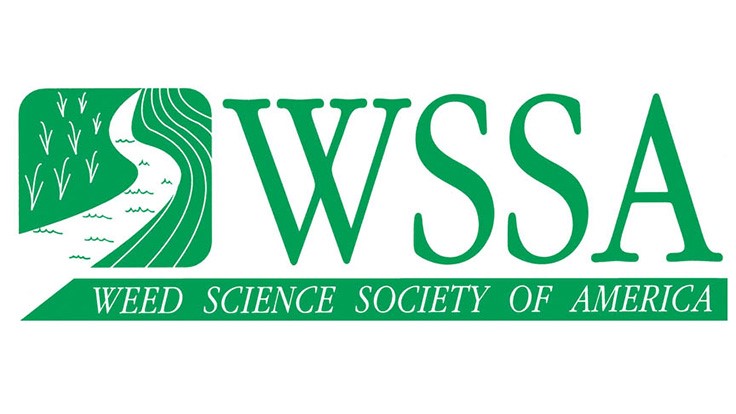
This summer Weed Science Society of America (WSSA) affiliates in the North Central and Southern regions gave nearly 100 students from 18 universities a chance to test their weed science know-how. Both organizations sponsored hard-fought competitions featuring multiple challenges – from identifying weeds at varying stages of growth to troubleshooting weed control issues faced by farmers in the field.
“For many students, the contests culminated months or even years of study,” says WSSA board member Delaney Foster, a graduate research assistant at The University of Tennessee and a winner in the Southern Weed Science Society contest. “Participants get hands-on experience in many of the practical aspects of weed science, including an opportunity to practice problem-solving skills that will benefit them as they enter the workforce.”
Details about the two events and the winners are below.
Wisconsin had a very strong showing in the North Central Contest hosted by North Dakota State University in Fargo. A total of sixty-one graduate and undergraduate students from 10 universities participated. The University of Wisconsin-Madison placed third overall in the graduate student division, with team members Nikola Arsenijevic, Felipe Faleco, Lindsay Malone and Haleigh Ortmeier-Clarke. Within individual competition, in the Farmer Problem, graduate student division, Lindsay Malone, of UW-Madison took first. Matt Humbert, also of UW-Madison topped the Calibration undergraduate division.
Other results from the North Central Contest include:
Top team performance, graduate
- Purdue University placed first, with team members Claudia Bland, Jesse Haarmann, Matt Osterholt and Ben Westrich. The same team also took top team honors for sprayer calibration.
- Kansas State University took second place with team members Isaac Barnhart, Chad Lammers, Luke Ryan and Sarah Zerger.
Top team performance, undergraduate
- Western Illinois University placed first, with team members Luke Bergschneider, Jacob Johnson, Stephanie Reiter and Dustin Steinkamp. The same team took top honors for sprayer calibration.
Top individual performance, graduate
- All three top individual performers were from Purdue University. Ben Westrich placed first, followed by Claudia Bland in second and by Jesse Haarmann in third.
Top individual performance, undergraduate
- Luke Bergschneider of Western Illinois University took first place, while his teammate Jacob Johnson placed second. Third place went to Taylor Nix of the University of Missouri.
Individual contests, solo performers, graduate
- Calibration: Matt Osterholt of Purdue University
- Weed ID: Navjot Singh of University of Minnesota
- Herbicide ID: Claudia Bland of Purdue University
Individual contests, solo performers, undergraduate
- Weed ID: Dustin Steinkamp, Western Illinois University
- Herbicide ID: Luke Bergschneider, Western Illinois University
- Farmer Problem: Luke Bergschneider, Western Illinois University
The 2021 Southern Weed Science Society Contest was hosted by Corteva Agriscience in Stoneville, Mississippi. Thirty-seven graduate students from eight Universities competed – supported by a team of 45 volunteers who helped to make the event happen. Results from the Southern Contest include:
Top team performance
- In the closest finish in the history of the event, the University of Arkansas took first place with team members Tristen Avent, Pamela Carvalho-Moore, Mason Castner, Lawson Priess and Maria Zaccaro.
- Scoring just two-tenths of a point behind the Arkansas team was Virginia Tech, with team members Daewon Koo, John Peppers, Eli Russell and Matthew Spoth.
- Louisiana State University placed third with team members Bradley Greer, David Walker, Connor Webster and John Williams.
Top individual performance
- Lawson Preiss from the University of Arkansas took top honors, followed by teammate Mason Castner, Eli Russell from Virginia Tech, Connor Webster from Louisiana State University and Hannah Wright from the University of Georgia.
Individual contest winners, team
- Calibration: The University of Tennessee took top honors with team members Trey Clark, Delaney Foster and Randall Landry.
- “Mystery Event” to build a small boat out of common craft items: Texas A&M University, placed first, with team members Zach Howard, Sarah Kezar, Andrew Osburn and Gustavo Silva.
Individual contest winners, solo performers
- Calibration: Delaney Foster of the University of Tennessee and Eli Russell of Virginia Tech (tied for first place)
- Weed ID: Connor Webster of Louisiana State University
- Herbicide ID: Lawson Priess of the University of Arkansas
- Farmer Problem: Hannah Wright of the University of Georgia
Alpaca Fiber Proves Popular
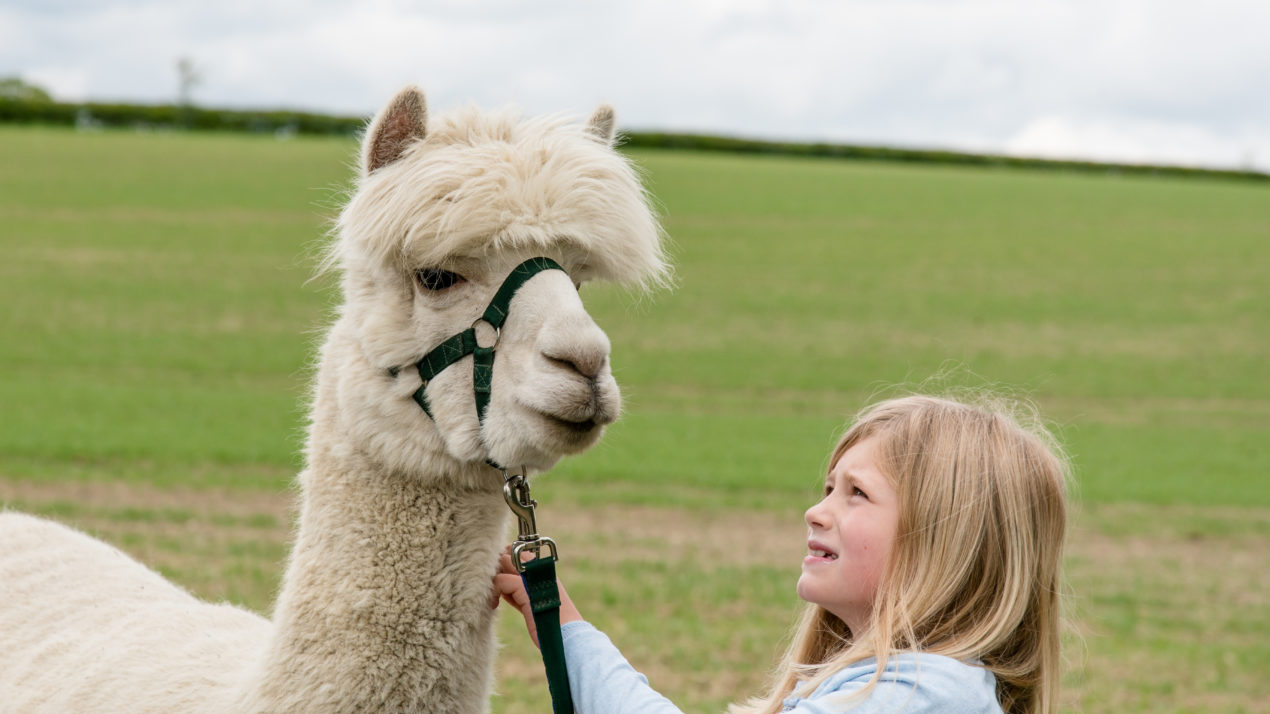
Ginny Olson of Fevolden Farm Alpacas in Black River Falls can be found at most festivals featuring animal fibers or local businesses. Her family’s farm raises alpacas for fiber and turns those fibers into products for crafts or fashion.
Olson says alpaca fiber is a sought out alternative to sheep’s wool because it is easier to clean and less irritating to the skin for some folks. This is because an alpaca’s fleece lacks lanolin — a natural oil found on sheep’s wool.
Fevolden Farm Alpacas, with ties in the Cottage Grove and Onalaska communities, belongs to the Cottage Grove Chamber of Commerce and Dane Buy Local. Olson says more people are seeking out locally produced items, creating demand for the farm’s 35 alpacas.
Olson and her husband Tom sell alpaca fleece and products out of their home studio in Cottage Grove. The farm also has an online presence, encouraged by the pandemic. Fevolden Farm Alpacas also has a brick-and-mortar store in Black River Falls.
Meet The Leopold Conservation Award Finalists
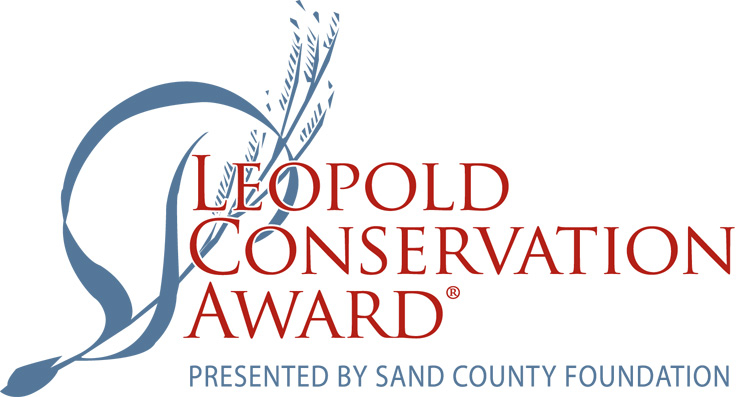
Three finalists have been selected for the 2021 Wisconsin Leopold Conservation Award. Given in honor of conservationist Aldo Leopold, the prestigious award recognizes farmers and forestland owners who inspire others with their dedication to land, water and wildlife habitat in their care.
In Wisconsin, the $10,000 award is presented annually by Sand County Foundation, American Farmland Trust, Wisconsin Farm Bureau Federation and Dairy Farmers of Wisconsin.
The finalists are:
Mike Berg of Blanchardville: Berg’s farm has long featured contour strips and no-till practices. Recently he’s planted more than 25,000 trees. Rip-rapping installed along the Pecatonica River has reduced erosion, minimized cropland damage from flooding, and improved fish habitat. Waterways are lined with grass buffer strips of at least 16 feet in width. Berg’s beef cattle are rotationally grazed in a manner than encourages grass growth while retaining soil.
Charlie Hammer and Nancy Kavazanjian of Beaver Dam: These early adopters of reduced-tillage farming methods are also leaders in other ecological ways to protect soil and water. Cover crops are incorporated into their corn, soybean and winter wheat crop rotation. Pollinator habitats and prairie strips of native wildflowers and grasses are installed within their crop fields. Duck scrapes and food plots provide wildlife habitat. Solar and wind energy systems reduce their farm’s carbon footprint and electrical bills.
John and Dorothy Priske of Fall River: The Priskes adopted no-till and rotational grazing practices, and installed grass waterways to improve water infiltration, sequester carbon and build organic matter in their soil. They raised and direct marketed Scottish Highland beef cattle until 2015. Their pastures provided deep-rooted ground cover to reduce soil erosion. The Priskes lease 165 acres of farmland to Madison College for use as an agricultural education facility.
This year’s recipient will be revealed later this year.
“Wisconsin farmers and farm families continue to innovate and excel towards sustainability goals,” says WFBF President Kevin Krentz. “These finalists are very deserving of the recognition for the work they are doing to leave the land, water and soil better for the next generation.”
The first Wisconsin Leopold Conservation Award was presented to woodland conservationist Gerry Mich of Appleton in 2006. The 2020 recipient was John and Melissa Eron of Stevens Point.
In his 1949 book, A Sand County Almanac, Leopold called for an ethical relationship between people and the land they own and manage, which he called “an evolutionary possibility and an ecological necessity.”
Sand County Foundation presents the Leopold Conservation Award to private landowners in 23 states with a variety of conservation, agricultural and forestry organizations. See more information: www.leopoldconservationaward.org
New Leadership For Beef Council
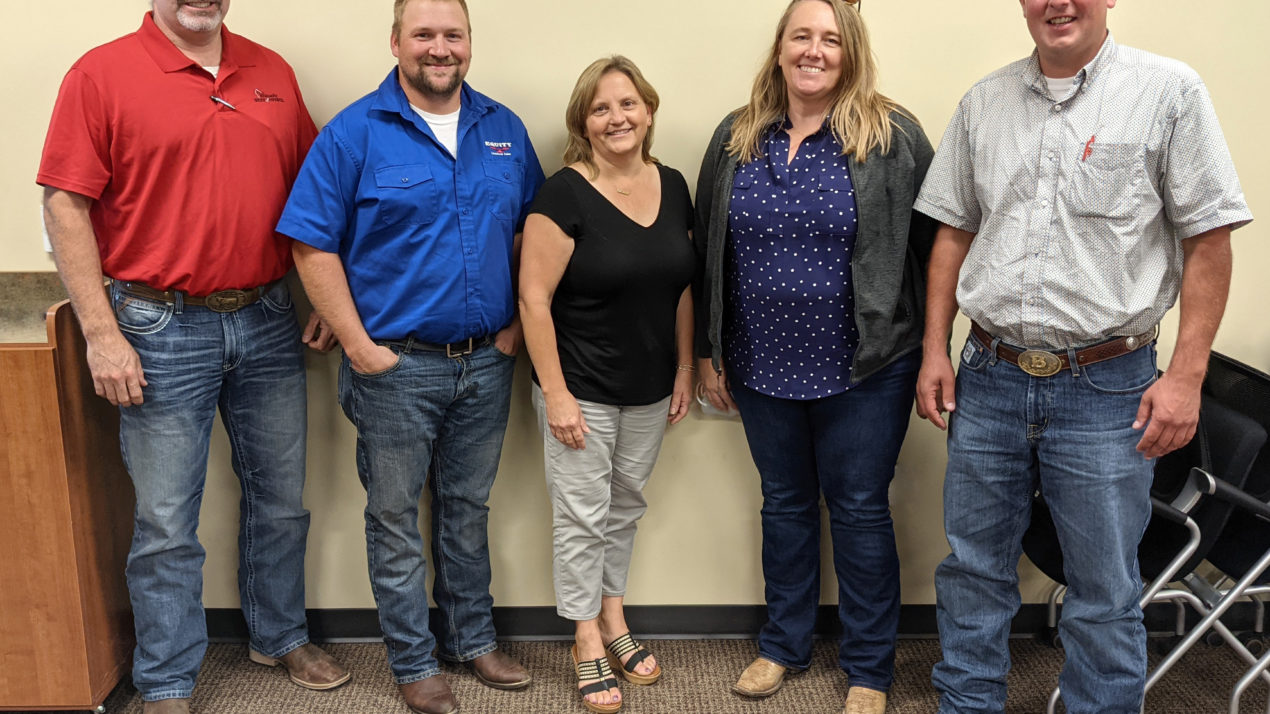
The Wisconsin Beef Council Board elected new leadership and established priorities to drive demand for beef in the 2022 fiscal year during its annual meeting held in September.
Rosie Lisowe, a dairy farmer from Chilton, Wis., will lead the 23-member board as president for the next two years. Lisowe serves on the board through appointment by the Wisconsin Farm Bureau Federation. Lisowe accepted the president’s role following Val Gaffney, a seedstock producer from Barneveld, Wis, who completed her two-year term.
“Being elected as president is an honor,” Lisowe said. “One of the goals I really would like to see is the producers knowing where their dollar is going and what it is being spent on to help move their product whether it is within the country or exporting it out of the country. I think there is great value there.”
Lisowe will also act as the Federation of State Beef Councils director on behalf of Wisconsin. Gaffney will continue to serve on the Executive Committee as past president.
The board elected Amy Radunz of Ellsworth, Wis. as president-elect. Radunz serves as one of the Wisconsin Cattlemen’s Association appointed board members. Curt Larson of Equity Cooperative Livestock Sales accepted the position of secretary-treasurer.
In addition to Lisowe, Radunz, and Larson, the board elected committee chairs and two at-large members to serve one-year terms on the Executive Committee. (Upon Larson’s election as secretary-treasurer, the Consumer Information Committee will select a new committee chair at a later date.)
Brad Solchenberger, Equity Cooperative Livestock Sales – Promotion Committee
Jim Rychtik, Milwaukee Stockyards – Producer Communications/Industry Information Committee
Brady Zuck, Wisconsin Cattlemen’s Association – At-Large Member
Jack Johnson, Wisconsin Cattlemen’s Association – At-Large Member
The following individuals completed their terms on the board and were recognized for their dedication to the beef industry:
Allan Cihlar, Equity Cooperative Livestock Sales
Dwight Truttman, Equity Cooperative Livestock Sales
Tina Hinchley, Wisconsin Farmers Union
Jay Heeg, Professional Dairy Producers of Wisconsin
Forrest Johnson, Central Livestock Association
The Wisconsin Beef Council Board is made up of individuals appointed by statewide organizations to serve three-year terms. Those individuals either pay the Beef Checkoff and/or collect the Checkoff. The organizations’ mission is to build beef demand that is sustainable for future generations.
Also during its annual meeting, the WBC Board approved the fiscal year 2022 budget which starts on October 1. The programs for the coming year will work to address the following core strategies that were identified in a recent board planning session. These strategies were prioritized by the board after review of the National Beef Industry Long Range Plan (beeflongrangeplan.com).
WBC Board Strategic Priorities
Promote and capitalize on the multiple advantages of beef
• Promote the role of beef in a healthy and sustainable diet
• Cultivate collaborative promotion partnerships
Grow Consumer Trust in Beef Production
• Educate medical professionals, diet and health experts about beef and beef production
• Collaborate with traditional and non-traditional partners to tell the positive story of beef cattle production
• Expand efforts in educating the general public about the BQA program and its impact on animal well-being
Drive growth in beef exports
• Collaborate with targeted partners to promote U.S. beef in foreign markets by investing in research, marketing, and education programs.
Hay Supply Favorable In Wisconsin
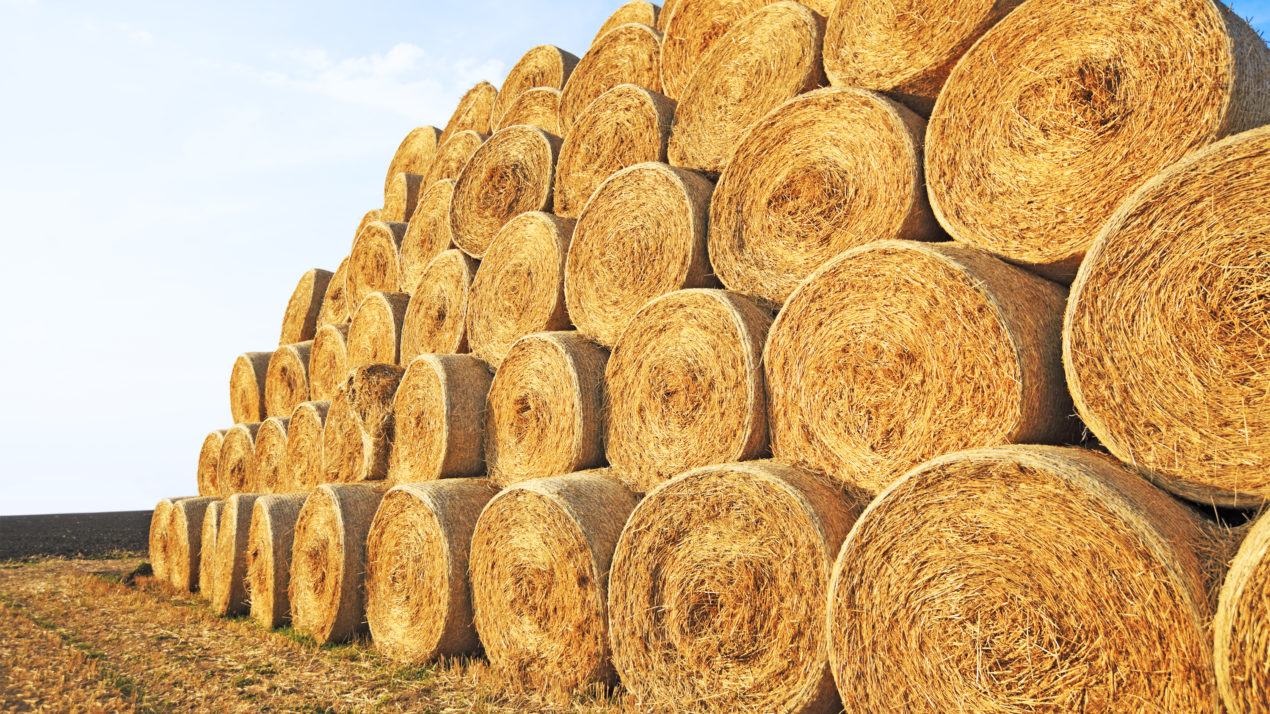
Hay making season is winding down here in the state of Wisconsin as fall is nearing. That will also increase the need to now feed some of those forages harvested to our livestock through the fall and winter. Richard Halopka, Crops & Soils Specialist with UW-Extension in Clark County shares a current hay market and supply update.
He reports that hay supply around the state is looking pretty decent this year going into fall. Central Wisconsin has had a wonderful growing season and has plenty of supply. As for some other dryer parts of the state, forage supplies are still adequate, even though they may have had a slow start. Interestingly, some nutritionists that Halopka has talked with have mentioned readjusting rations to use up any extra hay forage that farmers may have, in place of corn silage. He says working with your nutritionist can help decide what will be most cost effective depending on your forage supply.
Top dairy quality hay, over 150 relative feed value is still steady to strong in price. One change we have seen over the past few weeks is any lower quality forage, especially below 100 relative feed value is seeing a drop in price. A couple factors that play into that change are the availability of corn silage or alternative forages, and we are seeing many places in the United States that are dry and short on forage are marketing cattle early or moving them to other areas with less problems.
The last few years, harvesting alternative forages such as corn stalks or straw have been more popular to alleviate high hay prices. This year, Halopka says there will probably be a decent amount of alternative forage available, but farmers may decide not to harvest it if they don’t necessarily need it.
Halopka was also somewhat surprised when putting his last report together that straw prices have actually fallen some in comparison to the last few years. Quite a few producers grew small grains this past year, contributing to a decent supply of straw available. He reminds that even though wheat straw will usually draw a premium over other small grains, the prices don’t seem to be as high and demand isn’t quite as high at this time.
Click here to view Halopka’s most recent full hay market report.
Sheep Dairy Industry Small But Mighty
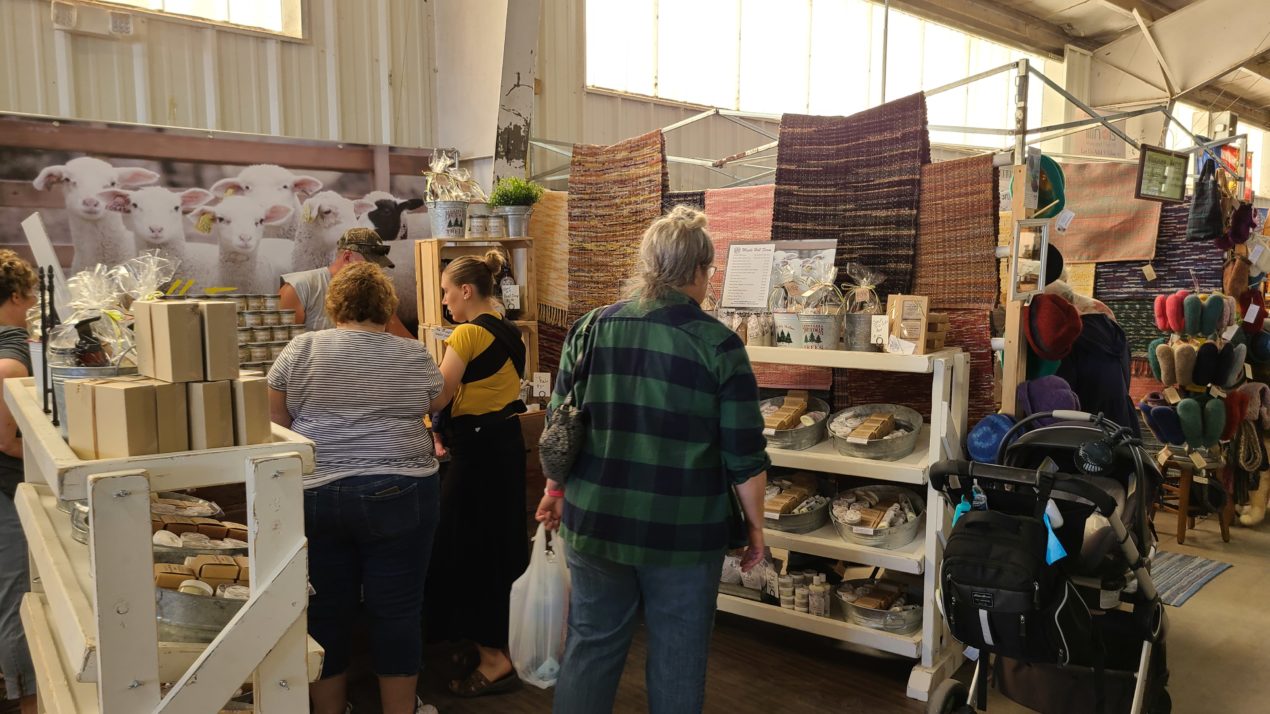
Wisconsin is the nation’s leader in dairy production, both when it comes to cows and goats. One less common, but still important piece to Wisconsin’s dairy industry is dairy sheep. A small but mighty industry, sheep milk products are gaining popularity with consumers and the small industry has a tough time even keeping up with growing demand.
Karen Nielsen, organization director for the Sheep Dairy Association of Wisconsin shares some of the unique qualities of sheep milk and details about the industry. Even though the industry is small, producers of dairy sheep are wide spread across the state of Wisconsin. Most of these sheep dairies ship their milk to be processed into cheese at multiple processors around the state.
There is somewhat of a difference in composition when comparing sheep and cows milk. Most notably, sheep milk is a bit more concentrated and higher in nutrient density, therefore giving it an advantage when it comes to processing. It takes less amount of milk to make the same amount of product. Cow’s milk contains more water, while sheep’s milk consists of about double the amount of fat and protein.
Hygiene products made with sheep’s milk are also becoming increasingly popular, especially for people with sensitive skin. Tammy and Brian Michielson, owners of Maple Hill Farm of Ladysmith, Wisconsin have expanded their business into creating a wide variety of these products. Tammy sells homemade soaps, lotions, bath products and many other things, made exclusively from their milking sheep flock. She mentions that the higher fat content in the milk helps to make the products more moisturizing and very popular with her customers. They milk about 75-100 sheep, with most of their milk going to cheese production. Michielson has continued to expand the business and also now has a greater online presence selling her products.

